Test audio file for ThereminoMCA
Files provided by Steven Sesselmann ( Variety Spectacular )
GS1100A-48khz _ CS137_1000pps (PCM – 16 bit – Mono – 48 KHz – 1 min. – 6 Megabytes)
GS1100A_Cs_Ba.zip (PCM – 16 bit – Mono – 192 KHz – 5 min. – 36 Megabytes)
GS1100A_Radium.zip (PCM – 16 bit – Mono – 192 KHz – 9 min, – 49 Megabytes)
Files provided by Alessio (Alex)
Alex-Ra226 _ 5_Nov
Alex-faint _ Cs137_5_nov_2012
Alex-VeryNoisy-Filtered _ 47k_10nF_Cs-137
Alex-47k _ 10nF_ConCesio
cs137_1 minute
A file with the user's Radio “oe8uww” GammaSpectrometry forum: https://docs.google.com/open?id=0B6CmPcoavHwjWGRkLVE3WUtyRG8
Send your test to audio files: livio@fastvr.com you will help to develop the ThereminoMCA and make it work better on your hardware.
Audio files must have a short name that is meaningful and follow the following rules.
ITALIAN LANGUAGE: The perfect audio files:
——————————————————————————————-
– main features in a short name like: “Robert_GS-1100A_Cs -137 _ K40”
– sample of Cesium at the right distance to produce approximately 100..200 pulses per second
– If possible also Americium to generate a third calibration point (must be away for about 30 cm approximately 150 ' ' for not making too high or low peaks compared to those of Cesium)
– with high energy pulses not saturated
– encoded as “PCM Signed Mono”
– with samples at 16 bit (not at 32 bit !!!)
– registered to 192 KHz (or 144, 96, 48 but only if they are wide enough not to produce ringing)
– along about 10 minutes and shortened if you can't compress it below 15 Mega Bytes
– compressed with 7Zip for maximum compression possible
After preparing this file you can also compress to MP3, reducing it to approximately 10 times (try with: “Layer3, 48000 Hz 128 Kbps, Mono” and check if the FWHM of caesium is not degraded) Further tests showed that with certain types of signal MP3 not good and greatly degrades the curve, so check them out well and compare the curves.
ENGLISH: The perfect test file:
——————————————————————————————-
– a short and meaningful name like: “Robert_GS-1100A_Cs -137 _ K40”
– cesium at the right distance to produce about 100..200 pulses per second
– maybe Americium to provide a third trimming point (must be about 30cm to 150 cm to balance the height of the Cesium and Americium main peaks)
– with high energy peaks not saturated
– codified as PCM Signed Mono
– 16 bit (not 32 bit !!!)
– recorded at 192 KHz (or 144, 96, 48 but only if they are large enough to avoid ringing)
– about ten minutes long but shortened if can not be compressed below 15 Mega Bytes
– compressed with 7Zip to reduce more possible
After preparing this file it is also possible to compress with MP3, reducing it by about 10 times (try: “Layer3, 48000 Hz 128 Kbps, Mono” and test if the FWHM of the cesium is degraded) Further tests have shown that with certain types of signal, the MP3 format is not OK and greatly degrades the curve, so test them and compare the curves.
Immagini dal file: Alex-Ra226 _ 5_Nov
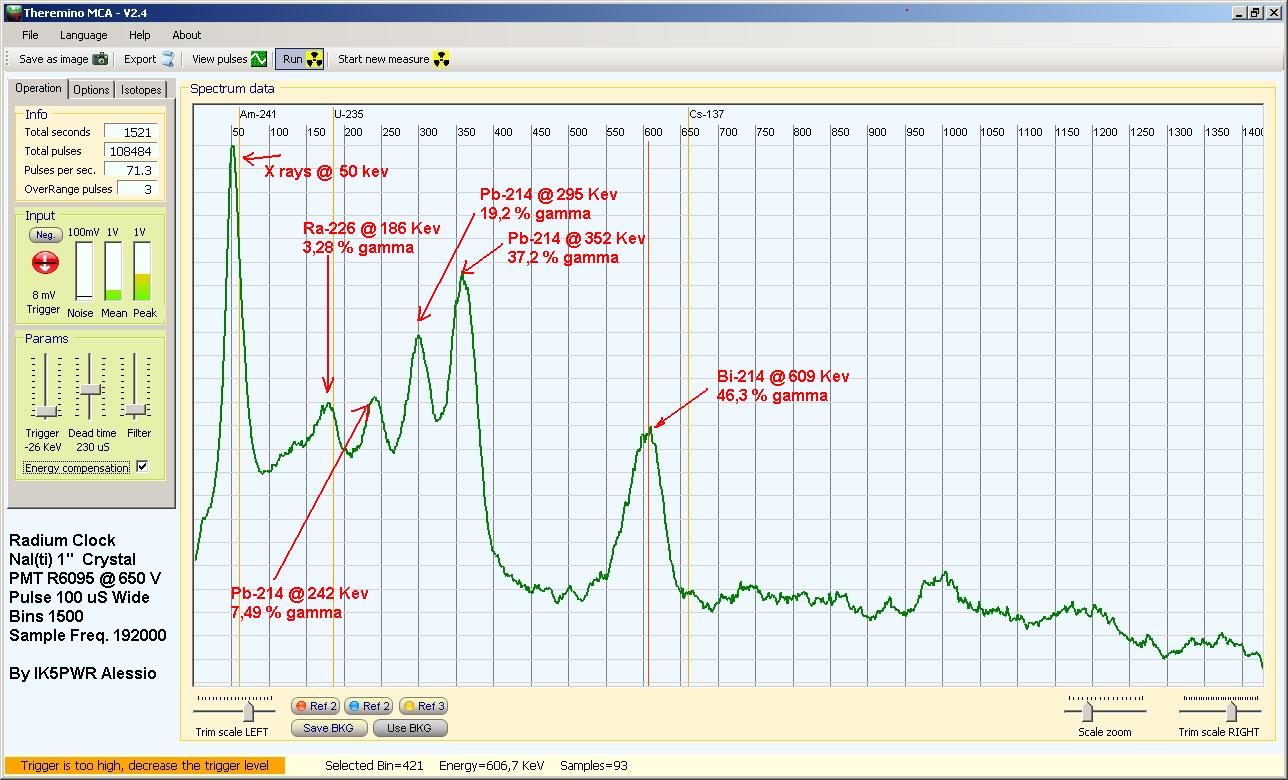 Radium – Plywood – This is the same file setup Alex-Ra226 _ 5_Nov but the League for 30 minutes.
Radium – Plywood – This is the same file setup Alex-Ra226 _ 5_Nov but the League for 30 minutes.
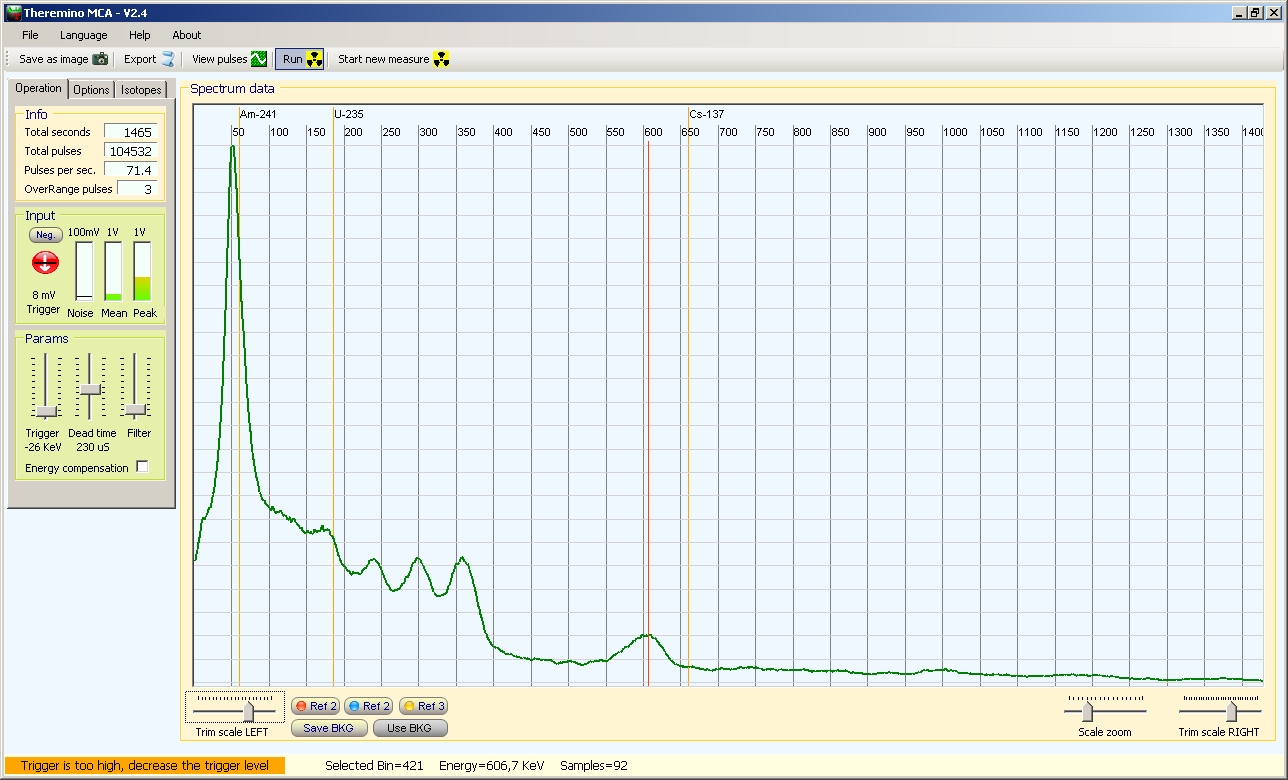
Radium – Not compensated – Without clearing the strong x-ray peak at about 50KeV lowers very the other peaks. It's always the same file setup Alex-Ra226 _ 5_Nov but the League for 30 minutes and without compensation.
–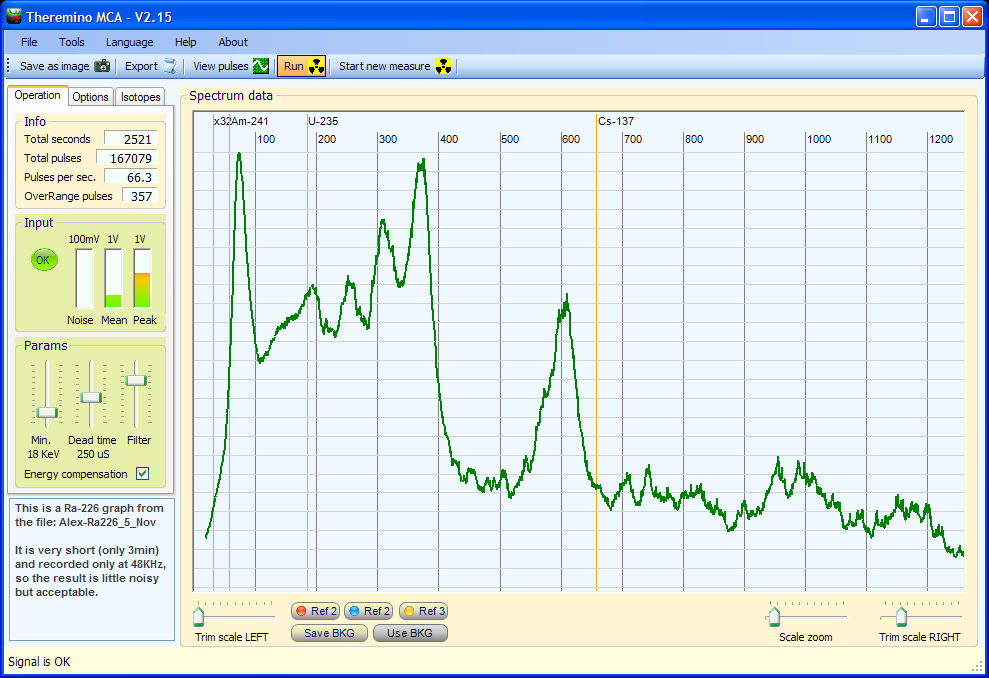 Radium – Compensated for this file Alex-Ra226 _ 5_Nov of only 3 minutes. Due to its short length, and also revising the file several times, remains always noisy, It would take at least ten minutes file.
Radium – Compensated for this file Alex-Ra226 _ 5_Nov of only 3 minutes. Due to its short length, and also revising the file several times, remains always noisy, It would take at least ten minutes file.
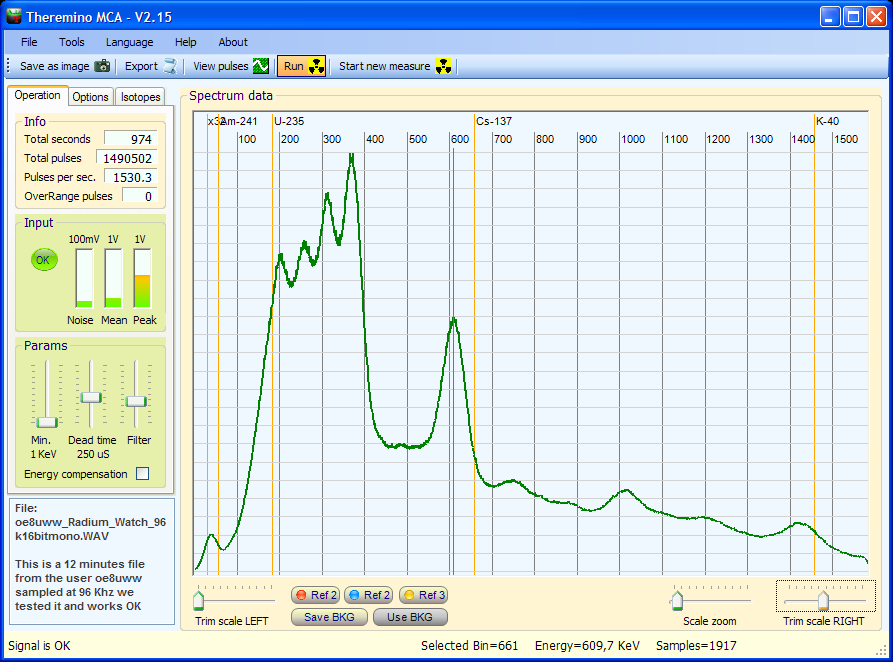 This and’ the file with the user's Radio “oe8uww” Yahoo forum GammaSpectrometry
This and’ the file with the user's Radio “oe8uww” Yahoo forum GammaSpectrometry
You download from here: https://docs.google.com/open?id=0B6CmPcoavHwjWGRkLVE3WUtyRG8
He wrote that with Theremino this file does not work but there were no problems to properly display all peaks of radio. With both positive impulses, both with negative impulses. (the pulses were folded up with the program GoldWave) Then we can assure him that this is not the pulse polarity but something that is dependent on its calibration data or sound card.
Immagini dal file: GS1100A_Cs_Ba.zip
 Cesium and Barium – Plywood
Cesium and Barium – Plywood
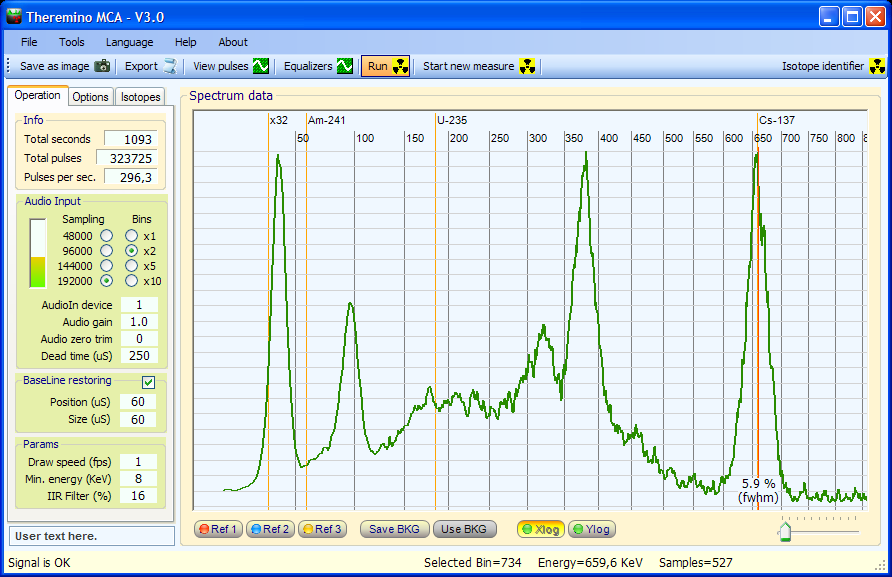 Cesium and Barium with ThereminoMCA V 3.0 – Notice the 5.9% and the great improvement in the area from 150 to 300 Kev
Cesium and Barium with ThereminoMCA V 3.0 – Notice the 5.9% and the great improvement in the area from 150 to 300 Kev
Immagini dal file: GS1100A_Radium.zip
The file: GS1100A_Radium.zip with MCA V 4.2
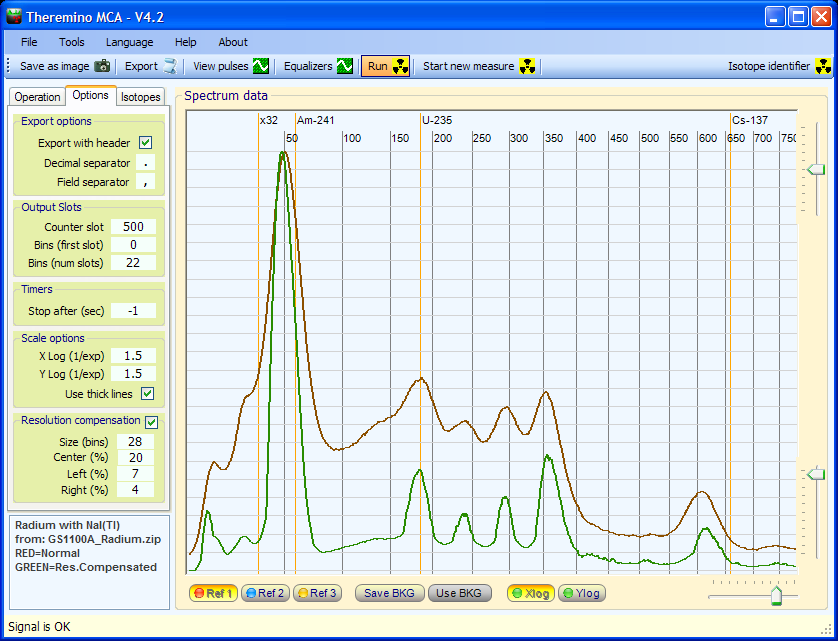
The same file as the previous image but with the new “Resolution compensation”
In red without compensation, Green has greatly increased the resolution compensation.

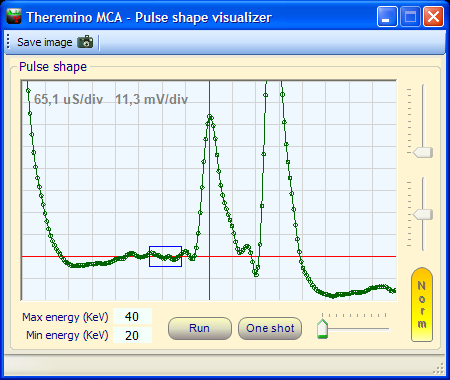
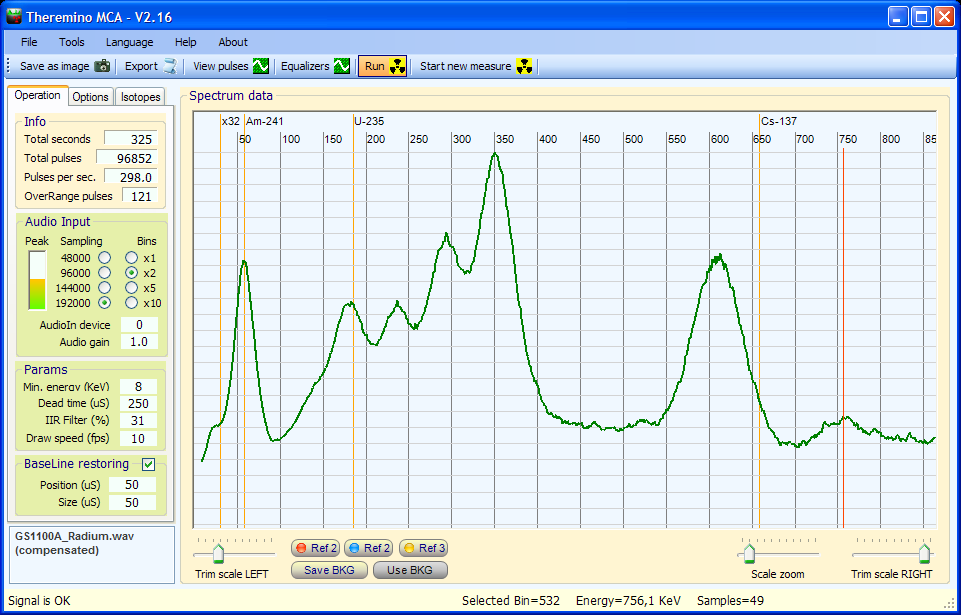
Some users are calling for more linearization capabilities and the mathematical mean of the Trim Left and Right Trim.
We try to answer to all the linearity-questions here.
The current Theremino_MCA version uses a simple correction method that mimics PRA in order to semplify the initial learning.
The actual formula is Energy = arb.units * X + K
the factor is the trim-right
the constant is the trim-left
Someone proposed a little improvement…
Energy = ( arb.units * X ) ^ e + K
This “factor / exponent / constant” method can be a little better because there are two linearity correction points
– the exponent corrects the high energy area
– the constant corrects the low energy area
But also this trick is matematically uncorrect.
(this can be easely demonstrated by the fact that the constant produces negative energies)
Linearizations
—————————————————————————————————————————————————————–
Now is the moment to implement the correct linearization, we plan to do this in the Version 3
– with a “Spline” with some fixed correction point (low energy / mid energy / hi energy)
– or with graphics “correction-ponts” that the user can add / remove / trim
– or with a “Lookup-Table” (a linearization file with a great number of correction points)
Each of those methods has advantages and problems, it is important to reduce the complexity seen by the user but it is also important a precision down the 1% (a pre-requisite for our PeakFitting algorithm to work well)
We need files with cesium, americium, radium and cobalt
and each radioactive sample must be at the right distance to balance the peak eights
—————————————————————————————————————————————————————–
Before to decide the linearization method we need many good files, it is not possible for us to find the right method to correct unknown non-linearity curves.
Now we have only files with a maximum of 2 points (32 and 660) and to correct 2 points all the curves are OK
When someone will send to us good files with many characteristics points we will begin the linearization work
Please send files according with the rules listed in this page
bye
Livio
Hallo,
where can I find something about the Theremino-Audio-Adapter ?
and where can I find the Geiger-Software ?
Best regards
Goeldner, Gottfried
Desired info are in the documentation of the ThereminoMCA and ThereminoGeiger applications.
You can download them from this page:
https://www.theremino.com/en/downloads/radioactivity/
Radioactivity sensors here:
https://www.theremino.com/en/hardware/inputs/radioactivity-sensors/
Schematics here:
https://www.theremino.com/en/technical/schematics/
Additional info in the Blogs (and in the sub-menu pages)
https://www.theremino.com/en/blog/geigers-and-ionchambers/
https://www.theremino.com/en/blog/geigers-and-ionchambers/environmental-monitoring/
https://www.theremino.com/en/blog/gamma-spectrometry/
Theremino System is growing rapidly so may be difficult to find all the info.
A good method is to use the Search Button, present in all the pages of the Theremino site.
And then, in the single pages, use CTRL-F to find single arguments.
Is there a way to have Thermino MCA play sound while it captures a gamma spectrum? This would help a lot in study of unusual gamma spectra. Thanks
The PmtAdapter sends the signal to the Theremino MCA application, using a standard Audio Card.
So you could use all the usual audio controls of the Windows system to “hear” the pulses.
And you can also use windows audio recorder applications (for example Audacity) to record the pulses as an audio file.
Then you could “play” the audio with an audio application (Audacity or Winamp or WindowsMediaPlayer) and “hear” the pulses.
Finally you could also select the played audio with the “Input” selector of the Theremino MCA and analyze it.
To do all this there are many requirements:
– Your audio card must have the ability to record what you hear
– Or you could use a “Virtual audio cable application”
– You must learn how to enable, use, and adjust the recording and playing levels of the windows recording and playback devices.
– You must disable all the audio enhancements and auto-levels.
– You must trim correctly the audio play and record levels and, when trimmed accurately, then never change them, because they have a drammatically effect on the MCA calibration. Increasing levels, all the energies are translated to the right. Decreasing levels, all the energies are translated to the left. Little variations of the recording and playing levels could translate energies so much that you see an absolutely strange graph.